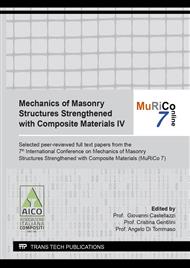p.123
p.130
p.136
p.147
p.155
p.163
p.172
p.180
p.186
Analysis of Linear Elastic Masonry-Like Solids Subjected to Settlements
Abstract:
A linear elastic no-tension material model is implemented in this contribution to cope with the analysis of masonry-like solids in case of either elastic or inelastic settlements. Instead of implementing an incremental non-linear approach, an energy-based method is adopted to address the elastic no-tension equilibrium. Under a prescribed set of compatible loads, and possible enforced displacements, a solution is found by distributing an equivalent orthotropic material having negligible stiffness in tension, such that the overall strain energy is minimized and the stress tensor is negative semi-definite all over the domain. A preliminary implementation of the proposed method is given by adopting a heuristic approach to turn the multi-constrained minimization problem into an unconstrained one. Numerical simulations focus on a wall with an opening subjected to either inelastic settlement or standing on elastic soil.
Info:
Periodical:
Pages:
155-162
Citation:
Online since:
April 2022
Authors:
Price:
Сopyright:
© 2022 Trans Tech Publications Ltd. All Rights Reserved
Share:
Citation:


